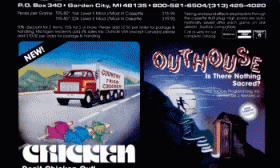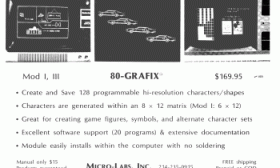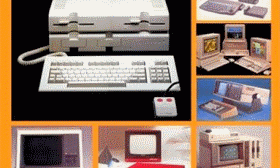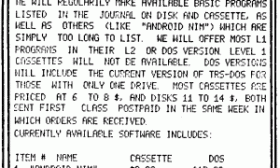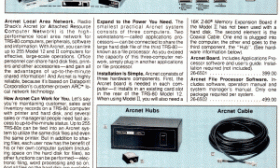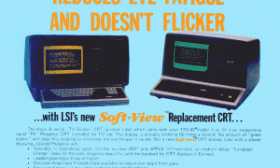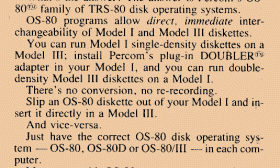80-GRAFIX
Many people considered the lack of high-resolution graphics to be the biggest deficiency of the TRS-80 Model I. The maximum resolution of the Model I was 128 by 48 by using block graphics. Many games made good use of that resolution, but it was still low compared to other computers.
The 80-GRAFIX was one of several high-resolution add-ons available for the Model I. Designed by Ted Carter, it was originally sold by Programma International for $149. The 80-GRAFIX fit entirely within the Model I case and required only minimal soldering.
The NADSBox Is Introduced
It isn’t everyday that a new piece of TRS-80 hardware is introduced. If you have been following the Model 100 mailing list, then you have already read about Ken Pettit’s development of the NADSBox. The NADSBox, which stands for New Age Digital Storage Box, is a memory card interface for the Model 100, Model 102, and Model 200 that supports SD, SDHC, and MMC memory cards.
Now the NADSBox is available for pre-order through Club 100, Rick Hanson’s excellent Model 100 user group and site. The pre-order cost for the NADSBox is $150.00. Shipping worldwide is $10. You can buy it along with a TS-DOS ROM for an additional $35.00. The cost will go up to $200.00 on January 1, 2009.
Collectible Microcomputers
The history of early microcomputers is a poorly documented subject and the amount of misinformation available is incredible. That’s why it is such a pleasure to read a book by someone knowledgeable about the subject. Collectible Microcomputers_ is just that book, a reference book for classic computers.
Long-time TRS-80 users may remember Michael Nadeau as a frequent contributor to 80 Micro, serving as senior copy editor, executive editor, and later editor-in-chief. He was also editor-in-chief of HOT CoCo magazine and the coordinator of the 80 Micro Anniversary issue.
Android Nim
Android Nim was Leo Christopherson’s first game for the TRS-80. It was featured on the cover of 80-Northwest Journal (later 80-U.S. Journal) in November 1978 and was released by 80-NW Publishing (later 80-U.S. Software). The cost was $8.00 for cassette and $13.00 for disk, with a $2.00 discount for 80-Northwest Journal subscribers. The game helped to popularize the magazine, and 80-U.S. Journal used an android for its mascot until 1981.
Soon after the original release, Leo Christopherson enhanced Android Nim with sound and more animation, developing the techniques known as “string-packing” and “line-packing” in the process. The enhanced version of Android Nim cost $14.95. Like all of Leo Christopherson’s TRS–80 games, Android Nim was written in combination of BASIC and machine language.
More About BASIC Over Shortwave
I recently wrote about a September 1981 Radio Netherlands experiment to broadcast BASIC programs over shortwave. The concept of broadcasting BASIC programs over radio wasn’t new to Holland. The Hobbyscoop program, which aired on NOS (a Dutch domestic broadcaster), regularly broadcast BASIC programs over mediumwave (more commonly called AM in the United States). But this was the first time such a broadcast was attempted on shortwave.
The experiment was conducted as part of the Media Network program, which aired Thursdays on Radio Netherlands. As a long-time listener to Media Network (although not at that time), I was curious about the experiment and the results. Jonathan Marks, the host and producer of Media Network, was kind enough to provide me with more details about the test.
An Interview with Jim Stutsman
I recently had the opportunity to interview Jim Stutsman, whose works include MICRODOS and DBLDOS for Percom and Monte’s Windows for Montezuma Micro. In the interview, conducted in October 2008, he had some very interesting answers to my questions and provided some fascinating insight into the early days of the TRS-80.ARCNET
ARCNET, which stands for Attached Resource Computer NETwork, is a networking standard that was created by Datapoint Communications in 1976. It was one of the first networking systems used by personal computers and provided a way for multiple computers to share printers and files. One of the primary advantage of ARCNET at the time was that it was substantially cheaper than its competitors, including Ethernet.
Radio Shack sold Arcnet cards and hardware for the Model II/12/16/6000 series starting in 1982. Arcnet cards were planned for the Model III and 4 but were never released. Two remnants of that planned support are the four functions labeled “Reserved for Arcnet” in the Programmer’s Guide to TRSDOS 6 and an Arcnet boot error message in the Model 4P ROM.
The Langley-St. Clair Soft-View Replacement CRT
One frequent criticism of the TRS-80 (especially the Model I) was the quality of the screen. Many complained of eyestrain and headaches after staring at the screen for a long time. Another frequent complaint was noticeable flicker, especially under poor lighting conditions.
One popular solution was the Soft-View replacement CRTs from Langley-St. Clair Instrumentation Systems, available for the Model I, Model III, Model 4, and Model 16. Their replacement CRTs used a slower-phosphor tube that was much easier on the eyes and virtually eliminated flicker. Here’s a quote from one of their advertisements:
